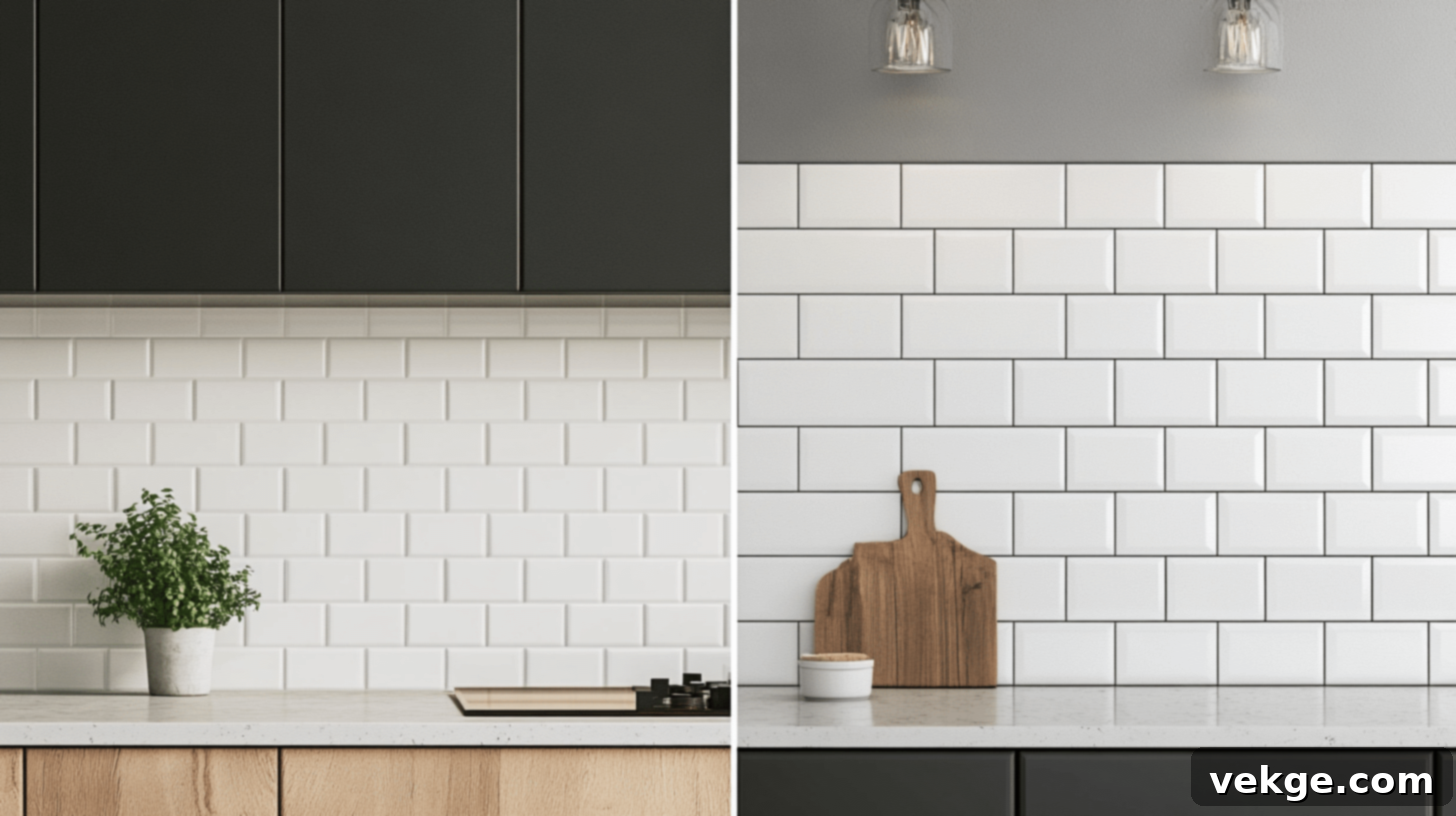Choosing the Perfect Subway Tile Grout Color: An Ultimate Guide for Stunning Spaces
The subtle yet significant choice of your subway tile grout color can profoundly impact the overall aesthetic and mood of any room. More than just a filler for the gaps between tiles, grout acts as a design element, capable of transforming a space from ordinary to extraordinary. It dictates how the tiles are perceived, influencing everything from the room’s perceived size to its specific style.
Selecting the ideal grout color is a critical decision that requires careful consideration. The right choice can elevate your interior design, enhance the architectural features, and even simplify maintenance. Conversely, a rushed or ill-informed decision can detract from your tiles’ beauty and leave your space feeling disjointed or dated.
In this comprehensive guide, we will delve deep into the art and science of choosing subway tile grout. We’ll explore why grout color holds such importance in design, examine popular color options that pair beautifully with classic white subway tiles, and discuss the various types of grout suitable for different areas. Additionally, we’ll cover the visual effects of grout line width, provide practical tips to help you make confident decisions, and highlight common pitfalls to avoid. Whether you’re planning a full bathroom renovation, a kitchen backsplash upgrade, or a simple decorative accent, these insights will empower you to select the perfect grout that harmonizes with your vision and achieves a truly professional finish.
Understanding the Transformative Impact of Grout Color
Grout’s role extends far beyond its structural function of filling crevices and securing tiles. It is a powerful design tool that can dramatically alter the perception of your tiled surfaces and the entire room. The color you select can make a space feel more expansive or cozy, cleaner or more inviting, and undeniably influence its overall character.
Why Grout Color Matters So Much in Design
The chosen grout color acts as a frame for each individual tile, fundamentally changing how the tiles themselves are viewed. For instance, a dark grout applied with light-colored tiles will create a stark contrast, making each tile edge stand out prominently. This defines a clear grid pattern, often evoking a classic, industrial, or vintage look. Conversely, a light grout that closely matches light tiles will create a more unified, seamless surface, making the wall appear as a single, continuous plane. This visual continuity can make smaller rooms feel larger and more open, lending an air of modern minimalism or understated elegance.
Beyond visual effects, grout color also plays a practical role in maintenance. In high-traffic or splash-prone areas like kitchens, a darker grout can effectively camouflage dirt, grime, and minor stains, making the space appear cleaner for longer. Conversely, a pristine white grout, while visually striking, will reveal every speck of dirt, demanding more frequent and meticulous cleaning. The wrong color choice can not only clash with your desired aesthetic but also lead to dissatisfaction with the upkeep, making grout color a choice that impacts both form and function.
Blend or Contrast: Which Aesthetic is Right for Your Space?
When selecting grout, you generally have two primary approaches: blending or contrasting. Each creates a distinct visual effect and caters to different design preferences and functional needs.
Blending Grout: The Seamless Look
Choosing a grout color that closely matches your tile color, such as white grout with white subway tiles, creates a harmonious and smooth appearance. This approach minimizes the visual impact of the grout lines, allowing the tiles themselves to be the star. The result is a clean, expansive, and often more contemporary feel. This method is excellent for making small spaces feel larger and less visually busy. From a practical standpoint, blending grout can also make minor imperfections in tile installation less noticeable, contributing to a more polished overall finish. It’s a popular choice for those seeking a minimalist or understated elegance, where the focus is on texture and light rather than strong patterns.
Contrasting Grout: The Defined Statement
Opting for a grout color that stands out against your tiles, such as black grout with white subway tiles, creates a striking visual pattern. This approach emphasizes each tile, highlighting its shape, size, and layout. The grid created by contrasting grout can add significant visual interest and a sense of architectural structure to a room. It’s a bold choice that can evoke specific styles, from classic vintage to modern industrial. While contrasting grout makes a stronger statement, it also requires more precision during installation, as any unevenness in tile spacing will be more apparent. It’s often preferred in larger spaces or areas where you want to add a dynamic focal point, such as a kitchen backsplash or a feature wall in a bathroom. Consider your personal style and the overall purpose of the room when making this crucial blend-or-contrast decision.
Best Grout Color Options for White Subway Tile
White subway tiles are renowned for their incredible versatility, serving as a blank canvas that can adapt to almost any design style. Your choice of grout color is key to unlocking their full potential, allowing you to imbue your space with a specific mood – be it modern, classic, bold, or warm.
1. White Grout – Timeless, Clean, and Expansive
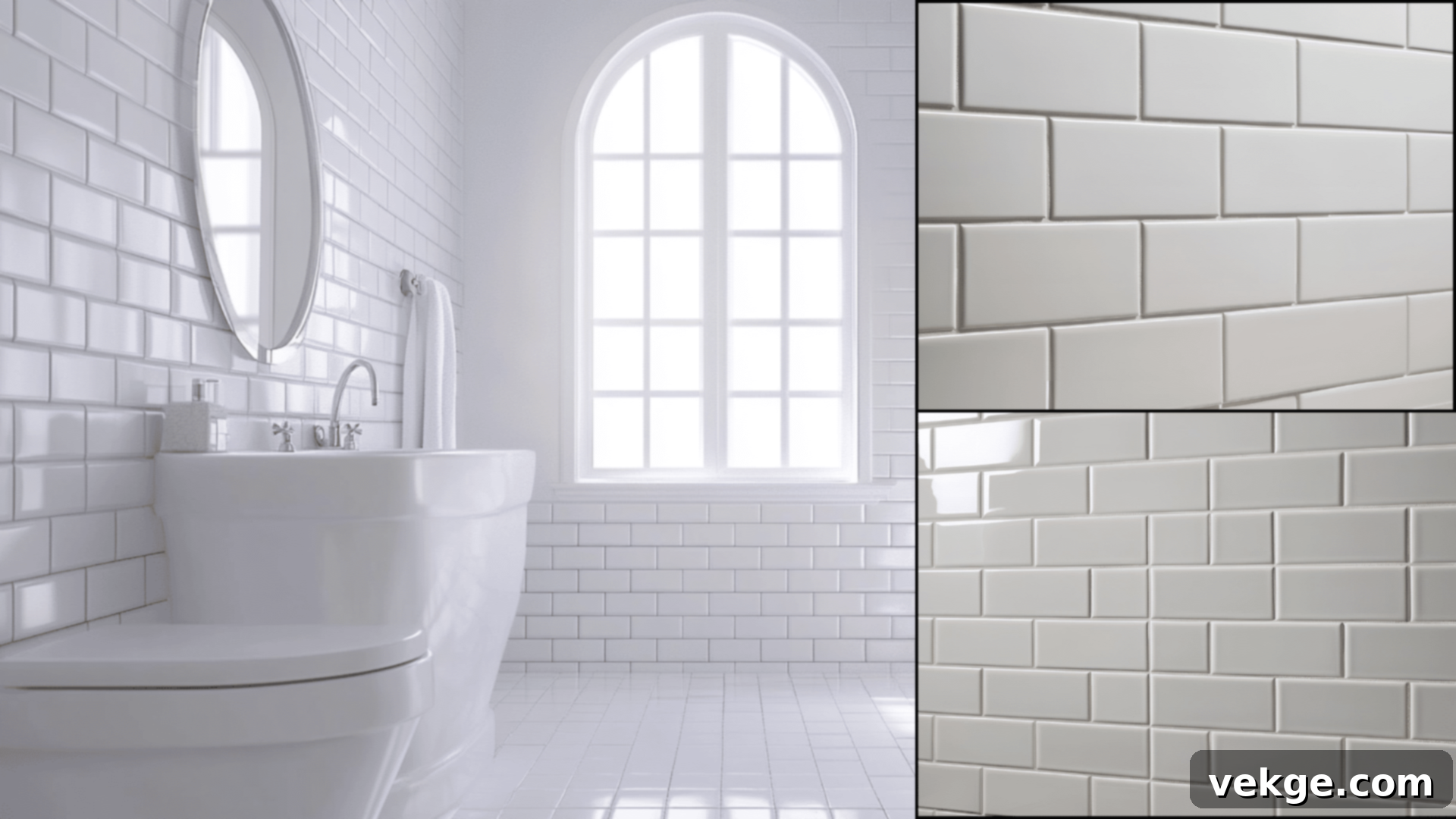
Pairing white grout with white subway tiles is a classic choice that never goes out of style. This combination creates a truly seamless and monochromatic look, where the tile and grout visually blend into one continuous surface. The result is an incredibly clean, crisp, and expansive feel, making it an ideal option for smaller bathrooms or kitchens where you want to maximize the sense of space and light. It evokes a sense of purity and serenity, perfect for minimalist, Scandinavian, or modern farmhouse aesthetics.
However, it’s important to note the practical considerations. White grout, by its very nature, is highly susceptible to showing dirt, grime, and stains, particularly in high-traffic or wet areas. Maintaining its pristine appearance will require consistent and diligent cleaning. To protect white grout and extend its fresh look, regular sealing is highly recommended. Despite the upkeep, the timeless elegance and bright, airy ambiance it creates make white grout a perennial favorite for those seeking a truly luminous and understated backdrop.
2. Gray Grout – Balanced, Versatile, and Low Maintenance
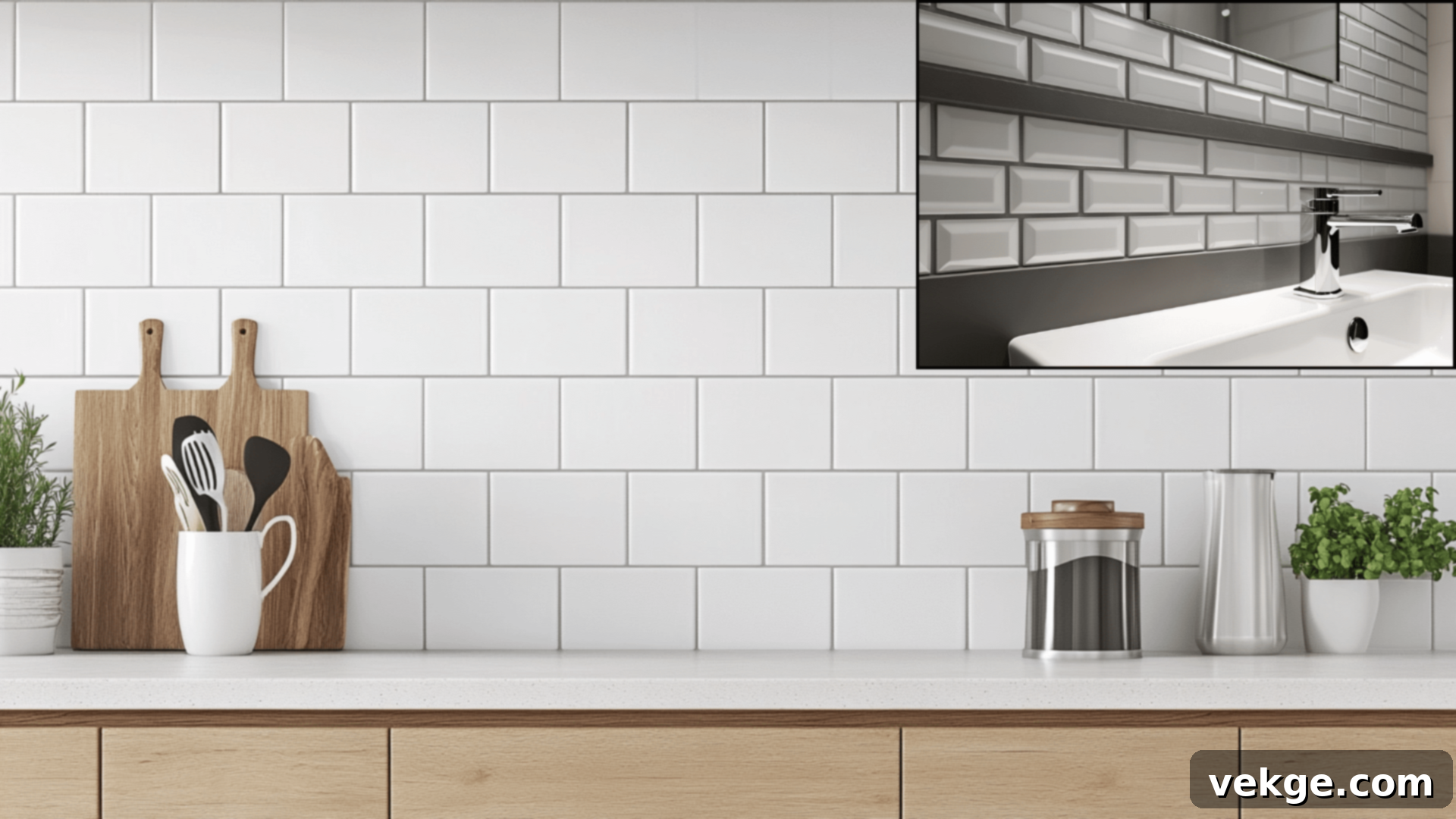
Gray grout offers a magnificent middle ground, balancing the clean appeal of white with the practical benefits of darker tones. Its versatility makes it a highly popular choice for white subway tiles across various design styles. Light gray grout provides a soft, subtle contrast that gently defines each tile without being overpowering, creating a sophisticated and contemporary look. It’s a step away from the starkness of white but still retains a bright and airy feel. Darker shades of gray, such as charcoal or slate, offer a more pronounced contrast, giving the tile pattern a clearer definition while still maintaining a modern edge.
One of gray grout’s most significant advantages is its low-maintenance nature. It effectively hides dirt, dust, and minor stains much better than white grout, making it an excellent choice for busy kitchens, high-use bathrooms, or mudrooms. Professional designers frequently recommend gray grout for its ability to stay looking fresh and clean even with daily use and the occasional spill. With a spectrum of shades available, from warm grays to cool grays, you have ample options to fine-tune the perfect hue that complements your overall color scheme and desired ambiance.
3. Black Grout – Bold, Dramatic, and Utterly Chic

For those looking to make a strong design statement, black grout with white subway tiles is an incredibly bold and dramatic choice. This high-contrast pairing ensures that each individual tile shape is crisply defined, transforming the tiled surface into a striking graphic pattern. This look is particularly well-suited for modern, industrial, or even vintage-inspired spaces, harkening back to the classic aesthetics of old butcher shops and subway stations.
Beyond its aesthetic impact, black grout offers superior practical benefits, especially in demanding environments. It is exceptionally effective at hiding dirt, stains, and discoloration, making it one of the lowest-maintenance options available. By creating such a stark contrast, black grout can also make white tiles appear even whiter and brighter by comparison, enhancing their pristine quality. While its strong visual presence is undeniable, consider the size of your space; in very small rooms, a high-contrast black and white pattern might feel too busy or visually heavy. However, when used thoughtfully, black grout creates an undeniably chic, sophisticated, and memorable look that stands out.
4. Brown or Taupe Grout – Warm, Earthy, and Inviting
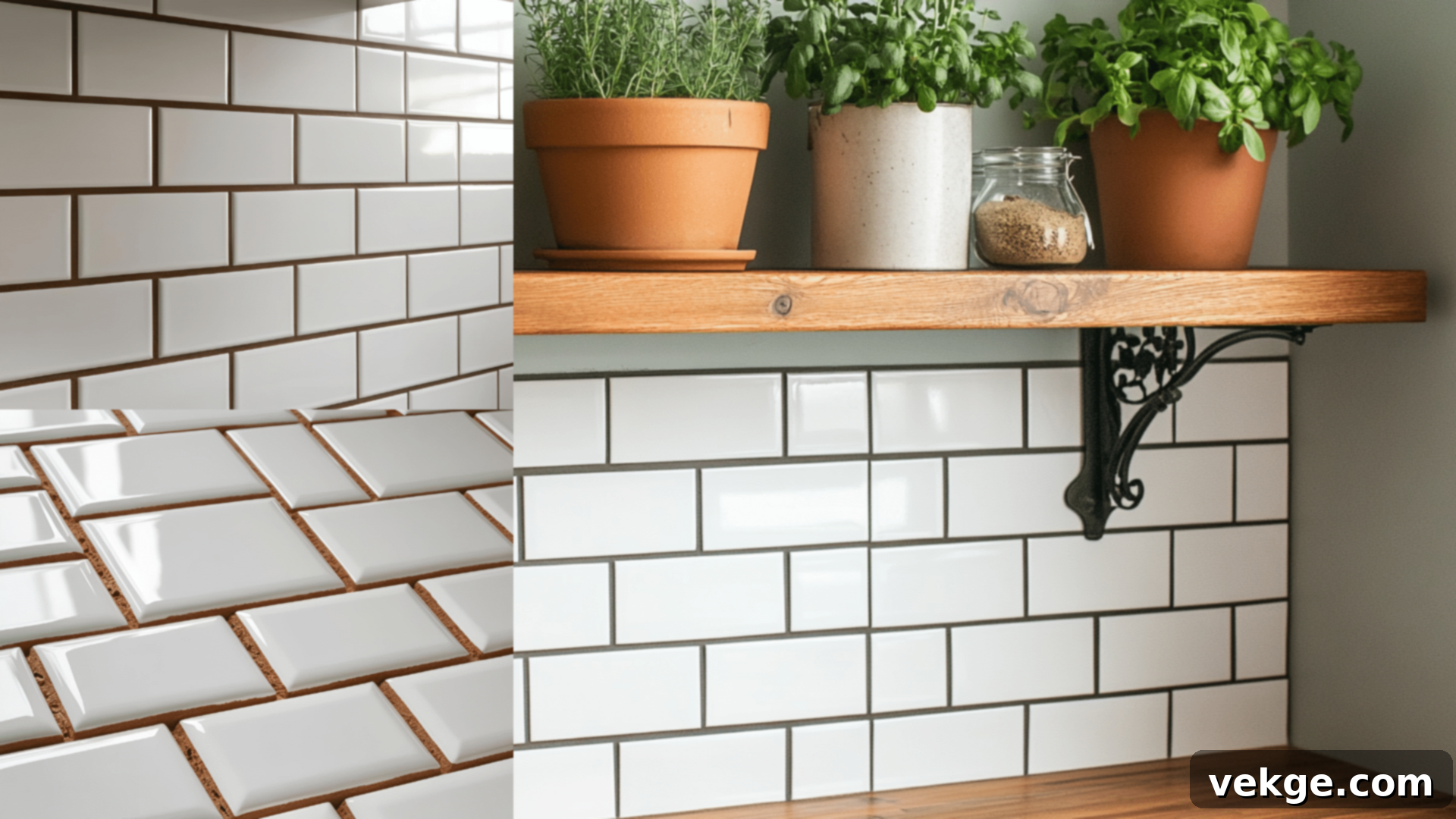
If your goal is to infuse warmth and an organic, earthy feel into a space adorned with white subway tiles, then brown or taupe grout colors are excellent contenders. These shades work beautifully in homes that embrace natural materials, wooden elements, and a cozy, inviting atmosphere. Light brown or sandy taupe grouts offer a soft, subtle contrast that evokes the feeling of natural stone or sun-baked earth, creating a welcoming and comfortable ambiance. Darker browns, on the other hand, provide a more noticeable contrast while still maintaining that inherent warmth, grounding the white tiles with a rich, natural tone.
Brown and taupe grouts are also highly practical, as their neutral tones are adept at concealing dirt and everyday grime, making them a sensible choice for busy areas like kitchen backsplashes or floors. They harmoniously pair with wooden cabinetry, natural stone countertops, or exposed brick, enhancing a rustic, farmhouse, or craftsman-style decor. This color family is perfect for softening the potentially stark or cold appearance of pure white tiles, adding a layer of depth and comfort that transforms a clinical feel into one of genuine hospitality.
5. Colored Grout – Creative, Personal, and Uniquely Yours
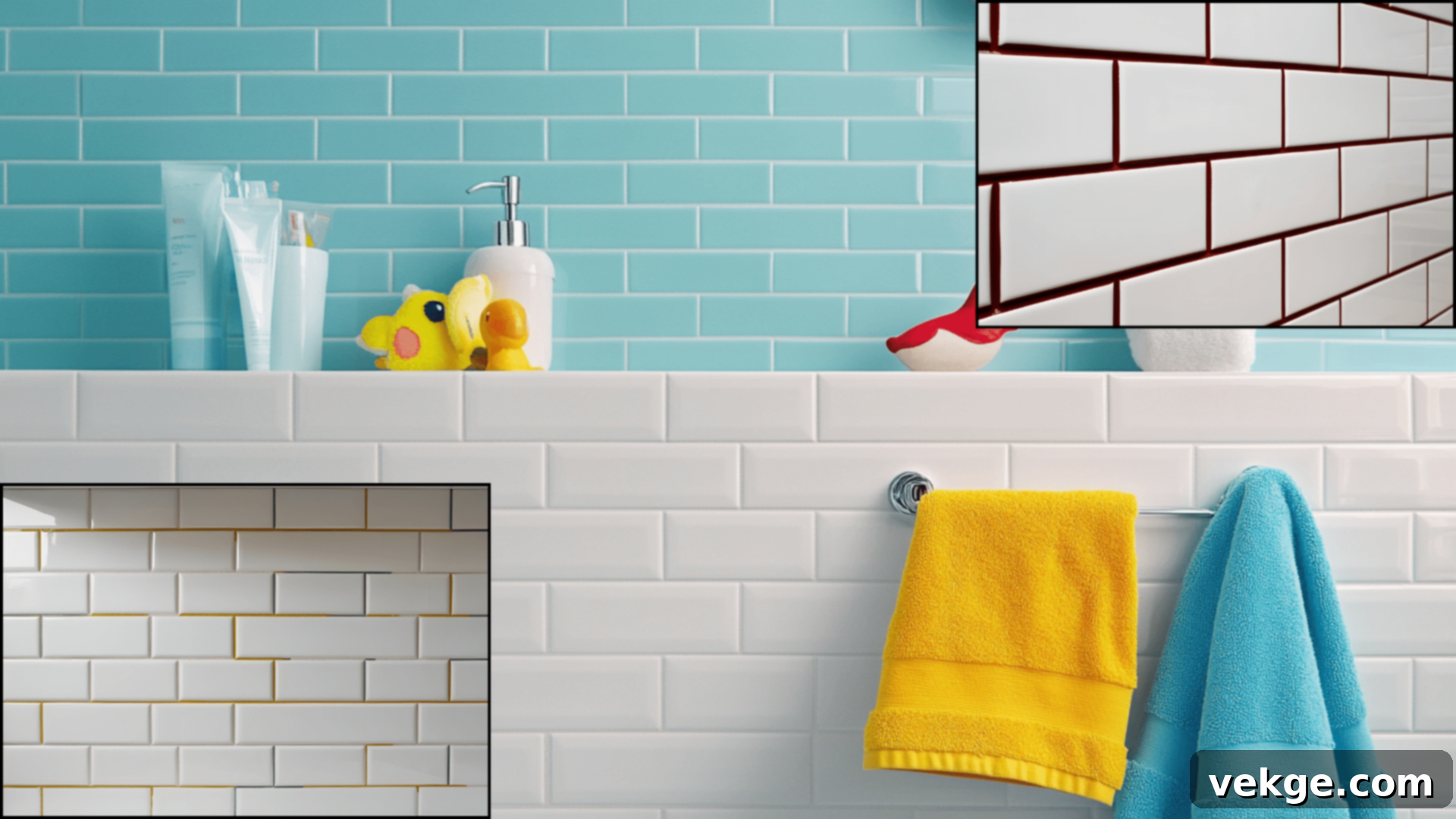
For the adventurous homeowner or designer, colored grout offers an exciting opportunity to inject personality, creativity, and a unique flair into your subway tile design. Imagine soft blues that evoke coastal serenity, vibrant greens that mimic nature, or even subtle pinks that add a playful touch. This approach allows you to step away from traditional neutrals and make a distinctive statement, often tying in with other accent colors or design elements within the room.
Colored grout transforms plain white subway tiles into a canvas for artistic expression, creating a feature that is both unexpected and memorable. It works exceptionally well in spaces where you want to foster a sense of fun, whimsy, or a highly personalized aesthetic, such as a child’s bathroom, a creative studio, or a uniquely styled kitchen. While this choice can lead to a truly standout space, it requires careful consideration. Ensure the chosen color complements enduring elements of your room to avoid a look that might quickly feel dated. Testing samples extensively and considering the long-term appeal are crucial steps when embracing the vibrant world of colored grouts, ensuring your creative vision remains timeless.
Grout Types and Textures: The Foundation of Durability
Beyond color, the type of grout you select plays a crucial role in its performance, durability, and appearance over time. Different formulations are designed for specific applications, joint widths, and levels of exposure to moisture and wear. Understanding the distinctions between these types is essential for a lasting and successful tiling project.
Sanded vs. Unsanded Grout: Making an Informed Choice
The primary distinction in standard cementitious grouts lies in the presence of sand, which directly impacts their application and characteristics:
| Feature | Sanded Grout | Unsanded Grout |
|---|---|---|
| Best for | Floors, wide joints, high-traffic areas | Walls, narrow joints, polished tiles |
| Joint width | 1/8″ (approx. 3mm) or wider | Less than 1/8″ (approx. 3mm) |
| Strength | More durable, less prone to cracking due to sand’s filler properties | Less durable, more prone to cracking in wider joints |
| Texture | Slightly rough, granular feel | Smooth, creamy finish |
| Cost | Generally less costly per bag | Often slightly more costly |
| Shrinkage | Less shrinking as sand provides stability | More shrinking, can pull away from tile edges |
| Good for | Kitchen floors, bathroom floors, exterior tiling | Bathroom walls, shower walls, backsplashes |
| Scratch risk | Can scratch highly glossy or delicate tile surfaces | Safer for polished, glass, or fragile tile materials |
Sanded grout contains fine sand particles that provide bulk and strength, preventing shrinkage and cracking in wider grout lines. It’s the go-to for floor applications and any joints 1/8 inch or wider. Unsanded grout, with its smooth, paste-like consistency, is ideal for narrower grout lines (typically less than 1/8 inch) and for delicate or highly polished tiles, as the sand in sanded grout could scratch their surfaces. Its smooth texture also makes it easier to work with in tight spaces and vertical applications.
Performance Grout for High-Traffic and High-Moisture Areas
For areas that experience heavy foot traffic, constant moisture, or frequent spills, conventional cementitious grouts may not offer sufficient protection. This is where “performance grouts” come into play. These advanced formulations, often epoxy-based or urethane-based, represent a significant upgrade in durability and stain resistance.
Epoxy grout, for example, is renowned for its exceptional water resistance, stain-proofing, and chemical resistance. It doesn’t require sealing and is incredibly tough, making it the superior choice for showers, commercial kitchens, and any area prone to extreme wear. Urethane grout offers similar benefits with slightly easier workability. While performance grouts typically come at a higher cost and require a slightly more meticulous installation process due to their faster drying times, their long-term benefits in terms of reduced maintenance and superior longevity often justify the initial investment, especially for critical areas of your home.
When to Use Resin (Epoxy/Urethane) or Cementitious Grout
The choice between cementitious and resin-based grouts largely depends on the application’s specific demands and your budget. Cementitious grout, made from cement, sand (for sanded variants), polymers, and color pigments, is the traditional and most common type. It’s affordable, widely available, and relatively easy for DIYers to work with. However, it is porous and requires sealing to prevent water penetration and staining, especially in wet areas.
Resin-based grouts, such as epoxy or urethane, are a premium alternative. These chemical-resistant and non-porous formulations inherently resist water, stains, and mildew without the need for sealing. They are the top choice for wet environments like showers, tub surrounds, and kitchen backsplashes where hygiene and durability are paramount. While they are more expensive and can be more challenging to install due to their rapid curing time and sticky nature, their unparalleled performance makes them a worthwhile investment for areas that demand the highest level of protection and the lowest maintenance.
Grout Line Width and Its Visual Effect
The width of your grout lines is another critical design element that significantly influences how your tile pattern is perceived and the overall style of your tiled surface. It can alter the room’s feel, highlight or downplay the tiles, and define the space’s character.
| Feature | Narrow Grout Lines (1/16″ – 1/8″) | Wide Grout Lines (1/4″ or more) |
|---|---|---|
| Look | Modern, seamless, subtle texture | Classic, rustic, defined grid pattern |
| Space effect | Makes spaces feel larger, more open, less busy | Can make spaces feel cozier, or add architectural weight |
| Tile focus | Highlights the tile itself, minimizing grout presence | Emphasizes the grout pattern as a design element |
| Cleaning | Less grout surface to clean; appears cleaner longer with matching grout | More grout surface to maintain; dirt can be more noticeable with contrasting grout |
| Difficulty | Requires precise tile installation; minor irregularities are more visible | More forgiving during installation; hides slight imperfections better |
| Best for | Contemporary, minimalist, transitional homes; creating a sleek backdrop | Farmhouse, industrial, vintage, or traditional styles; enhancing a brick-like aesthetic |
| Wall effect | Smoother, more unified surface; elegant and understated | Adds texture and visual interest; creates a robust, handcrafted feel |
| With white subway | Clean, minimal, almost “invisible” tile; very modern | Strongly defined “brick” pattern; classic and enduring |
Narrow grout lines (typically 1/16″ to 1/8″) create a sleek, contemporary look. They minimize the visual interruption between tiles, allowing the tiles to almost blend into one another, which is ideal for achieving a minimalist or expansive feel. This width is often chosen for a more polished and modern aesthetic, where the tile itself is the focal point, and the grout lines are merely an understated detail.
Conversely, wider grout lines (1/4″ or more) create a more pronounced grid pattern, enhancing the individual shape of each subway tile. This approach often lends itself to more traditional, industrial, or farmhouse styles, reminiscent of classic brickwork. Wider lines can also be more forgiving during installation, as slight variations in tile spacing are less noticeable. When paired with a contrasting grout color, wide lines can create a powerful graphic statement, adding texture and a sense of history to a space. Your choice of grout line width should harmonize with your desired aesthetic and the overall scale of your room.
Practical Tips for Choosing the Right Grout
Beyond aesthetic preferences, several practical considerations should guide your grout selection process. Making an informed decision ensures your tiled surface looks great and functions well for years to come.
- Consider the Lighting: The light in your room, both natural and artificial, dramatically affects how grout colors appear. A color that looks perfect under fluorescent store lighting might look entirely different in your home’s natural daylight or warm evening lamps. Always test grout samples in your actual space and observe them at different times of the day.
- Harmonize with Existing Elements: Your grout choice should complement the surrounding elements in the room, such as cabinetry, countertops, wall paint, and flooring. If you have warm-toned wood cabinets, a cool-toned gray grout might clash, whereas a taupe or warm gray could provide better harmony.
- Account for Room Size and Purpose: In smaller rooms, lighter, blending grout colors can make the space feel larger and more open. In contrast, larger rooms can handle more dramatic contrasting grout without feeling overwhelmed. For high-moisture areas like showers, prioritize water-resistant grout types like epoxy. For busy kitchens, stain-resistant options or darker colors are practical.
- Maintenance Expectations: Be realistic about how much cleaning you’re willing to do. Pristine white grout in a high-traffic area will require diligent cleaning and sealing. If low maintenance is a priority, opt for medium-toned grays, taupes, or even performance grouts that naturally resist stains.
- Test, Test, Test: This cannot be stressed enough. Purchase small samples of your top grout color choices. Apply them to a small, inconspicuous area or on spare tiles arranged on a piece of cardboard. Let them dry completely, as grout often lightens or darkens as it cures. Live with these samples for a few days to truly gauge their appearance in your home environment before committing to the entire project.
- Consult a Professional: If you’re still unsure, don’t hesitate to consult with a tile installer or an interior designer. Their experience can be invaluable in guiding you toward the best choice for your specific project and ensuring a flawless finish.
Common Mistakes to Avoid When Choosing Grout
Even with careful planning, it’s easy to fall into common traps when selecting grout. Being aware of these mistakes can save you time, money, and potential regret.
- Ignoring Tile Undertones: Many “white” tiles aren’t pure white; they often have subtle undertones of cream, gray, or even blue. Choosing a stark, bright white grout with an off-white or creamy tile can make the tiles appear dingy or dirty by comparison. Always hold your grout sample directly against your specific tiles to ensure their undertones harmonize.
- Not Testing Grout Samples in Situ: Relying solely on grout swatches in a store, or even a wet sample, is a recipe for disappointment. Grout colors can shift significantly when dry, and lighting conditions in your home are unique. Always apply and dry a small sample of your chosen grout directly on spare tiles in the actual room where it will be installed.
- Underestimating Cleaning and Maintenance Needs: Selecting a light-colored, porous grout for a high-traffic area like a kitchen backsplash or a frequently used shower without considering the required upkeep is a common error. This often leads to visible stains, mildew, and frustration. Match your grout choice to your lifestyle and maintenance tolerance, prioritizing stain-resistant options for demanding areas.
- Using the Wrong Grout Type for the Application: Floors require the strength and crack resistance of sanded grout for wider joints. Walls with very narrow joints, or delicate glass/polished tiles, need the smooth finish and non-abrasive nature of unsanded grout. Using unsanded grout on a floor or sanded grout with polished glass tiles can lead to structural failure or unsightly scratches, respectively.
- Chasing Fleeting Trends with Permanent Choices: While a vibrant, unusually colored grout might seem exciting now, consider its long-term appeal. Grout is notoriously difficult and costly to change without replacing the entire tile installation. Opting for overly trendy colors in permanent fixtures might lead to quick aesthetic fatigue. Stick to more timeless options or use bolder colors sparingly as accents in areas that are easier to refresh.
Wrapping Up: Your Path to Perfect Subway Tile Grout
The journey to selecting the perfect grout color for your subway tiles is a nuanced but incredibly rewarding one. Remember, grout is far more than just a functional filler; it is an integral design element that shapes the mood, defines the style, and impacts the practical longevity of your tiled spaces. By thoughtfully considering how you use the room, your desired aesthetic, and your maintenance preferences, you can narrow down the choices and make a decision that you’ll love for years to come.
Embrace the power of blending for a seamless, expansive look, or dare to contrast for a bold, defined statement. Explore the timeless elegance of white, the balanced versatility of gray, the dramatic flair of black, the inviting warmth of brown, or the personal touch of colored grouts. Always factor in the right grout type – sanded for wide joints and floors, unsanded for narrow joints and delicate walls, and performance grouts for ultimate durability in wet or high-traffic areas.
Above all, the golden rule remains: always test your chosen grout samples in your actual space. Observe them under varying light conditions and allow them to cure completely before making your final commitment. This simple step can prevent costly mistakes and ensure that your vision translates flawlessly into reality. Your perfect grout match is waiting to be discovered, and with the insights gained from this guide, you are now equipped to make a choice that will make your subway tile installation look truly professional and impeccably stylish.
Ready to transform your space? This weekend, gather a few sample colors and witness their magic against your tiles in different lighting. The right grout will not only complete your tiling project but elevate it to a work of art.
